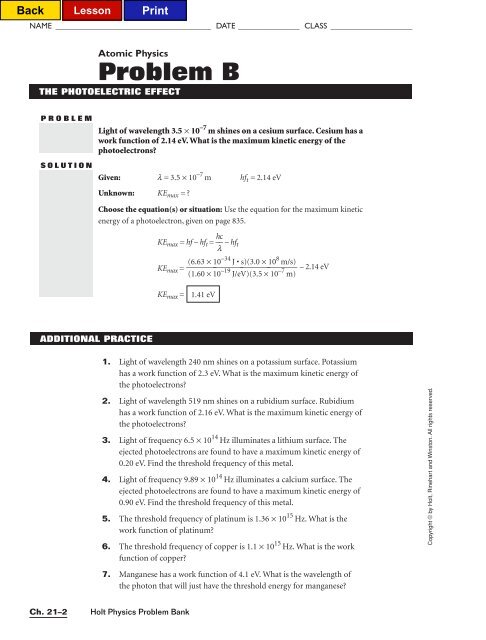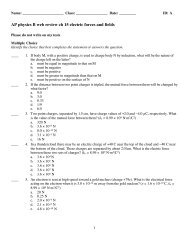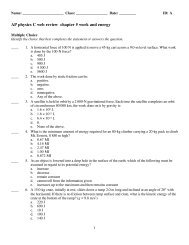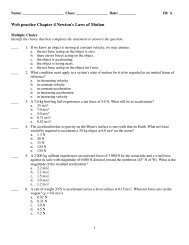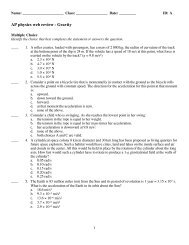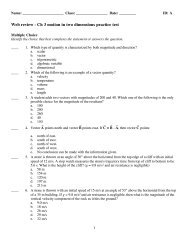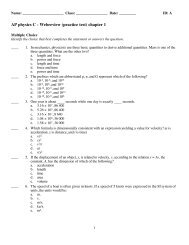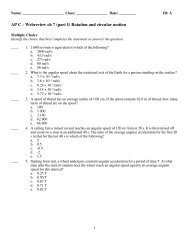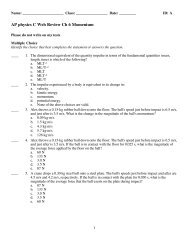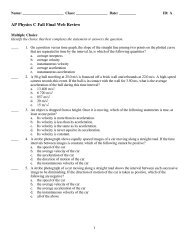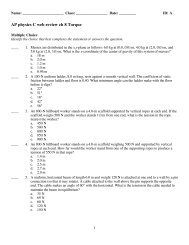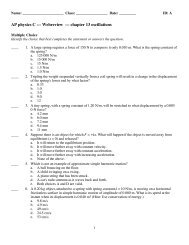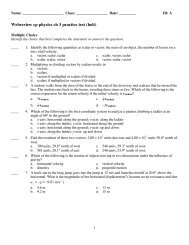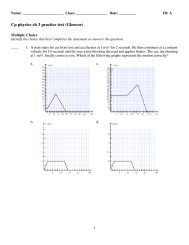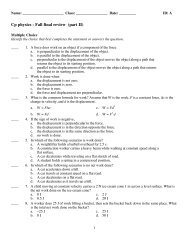Problem B Copyright reserved
photoelectric 2 - Planet Holloway
photoelectric 2 - Planet Holloway
Create successful ePaper yourself
Turn your PDF publications into a flip-book with our unique Google optimized e-Paper software.
NAME ______________________________________ DATE _______________ CLASS ____________________<br />
Atomic Physics<br />
<strong>Problem</strong> B<br />
THE PHOTOELECTRIC EFFECT<br />
PROBLEM<br />
SOLUTION<br />
Light of wavelength 3.5 × 10 –7 m shines on a cesium surface. Cesium has a<br />
work function of 2.14 eV. What is the maximum kinetic energy of the<br />
photoelectrons?<br />
Given: l = 3.5 × 10 –7 m hf t = 2.14 eV<br />
Unknown: KE max = ?<br />
Choose the equation(s) or situation: Use the equation for the maximum kinetic<br />
energy of a photoelectron, given on page 835.<br />
KE max =hf– hf t = h c<br />
⎯⎯ – hf t<br />
l<br />
KE max =<br />
KE max = 1.41 eV<br />
(6.63 × 10 –34 J • s)(3.0 × 10 8 m/s)<br />
⎯⎯⎯⎯<br />
(1.60 × 10 –19 J/eV)(3.5 × 10 –7 m)<br />
– 2.14 eV<br />
ADDITIONAL PRACTICE<br />
1. Light of wavelength 240 nm shines on a potassium surface. Potassium<br />
has a work function of 2.3 eV. What is the maximum kinetic energy of<br />
the photoelectrons?<br />
2. Light of wavelength 519 nm shines on a rubidium surface. Rubidium<br />
has a work function of 2.16 eV. What is the maximum kinetic energy of<br />
the photoelectrons?<br />
3. Light of frequency 6.5 × 10 14 Hz illuminates a lithium surface. The<br />
ejected photoelectrons are found to have a maximum kinetic energy of<br />
0.20 eV. Find the threshold frequency of this metal.<br />
4. Light of frequency 9.89 × 10 14 Hz illuminates a calcium surface. The<br />
ejected photoelectrons are found to have a maximum kinetic energy of<br />
0.90 eV. Find the threshold frequency of this metal.<br />
5. The threshold frequency of platinum is 1.36 × 10 15 Hz. What is the<br />
work function of platinum?<br />
6. The threshold frequency of copper is 1.1 × 10 15 Hz. What is the work<br />
function of copper?<br />
7. Manganese has a work function of 4.1 eV. What is the wavelength of<br />
the photon that will just have the threshold energy for manganese?<br />
<strong>Copyright</strong> © by Holt, Rinehart and Winston. All rights <strong>reserved</strong>.<br />
Ch. 21–2<br />
Holt Physics <strong>Problem</strong> Bank
NAME ______________________________________ DATE _______________ CLASS ____________________<br />
8. Cobalt has a work function of 5.0 eV. What is the wavelength of the<br />
photon that will just have the threshold energy for cobalt?<br />
9. Light shines on a photoelectric metal and the maximum kinetic energy<br />
is measured to be 0.6 eV. What is the speed of the photoelectrons?<br />
10. Light shines on a photoelectric metal and the maximum kinetic energy<br />
is measured to be 1.2 eV. What is the speed of the photoelectrons?<br />
<strong>Copyright</strong> © by Holt, Rinehart and Winston. All rights <strong>reserved</strong>.<br />
<strong>Problem</strong> B Ch. 21–3
<strong>Problem</strong> Bank Answers<br />
Additional Practice A<br />
Atomic Physics<br />
Givens<br />
1. λ=527 nm = 5.27 × 10 −7 m<br />
Solutions<br />
E = hf = ⎯ h c<br />
⎯ =<br />
λ<br />
(6.63 × 10 −34 J •s)(3.00 × 10 8 m/s)<br />
⎯⎯⎯⎯<br />
5.27 × 10 −7 m<br />
= 3.77 × 10 −19 J<br />
2. λ=430.8 nm<br />
λ = 4.308 × 10 −7 m<br />
E = hf = ⎯ h c<br />
⎯ =<br />
λ<br />
(6.63 × 10 −34 J •s)(3.00 × 10 8 m/s)<br />
⎯⎯⎯⎯<br />
4.308 × 10 −7 m<br />
= 4.62 × 10 −22 J<br />
3. E = 20.7 eV<br />
f = ⎯ E h ⎯ = (20.7 eV)(1.60 × 10 −19 J/eV)<br />
⎯⎯⎯ = 5.00 × 1015 Hz<br />
6.63 × 10 −34 J •s<br />
4. E = 1.24 × 10 −3 eV<br />
f = ⎯ E h ⎯ = (1.24 × 10 −3 eV)(1.60 × 10 −19 J/eV)<br />
⎯⎯⎯⎯ = 2.99 × 1011 Hz<br />
6.63 × 10 −34 J •s<br />
5. E = 1.78 eV<br />
f = ⎯ E h ⎯ = (1.78 eV)(1.60 × 10 −19 J/eV)<br />
⎯⎯⎯ = 4.30 × 1014 Hz<br />
6.63 × 10 −34 J •s<br />
6. E = 12.4 MeV<br />
E = 1.24 × 10 7 eV<br />
λ= ⎯ h c<br />
⎯ =<br />
E<br />
(6.63 × 10 −34 J •s)(3.00 × 10 8 m/s)<br />
⎯⎯⎯⎯<br />
(1.24 × 10 7 eV)(1.60 × 10 −19 J/eV)<br />
= 1.00 × 10 −13 m<br />
<strong>Copyright</strong> © by Holt, Rinehart and Winston. All rights <strong>reserved</strong>.<br />
7. E = 939.57 MeV<br />
E = 9.3957 × 10 8 eV<br />
8. E = 3.1 × 10 −6 eV<br />
Additional Practice B<br />
1. λ=240 nm = 2.4 × 10 −7 m<br />
hf t = 2.3 eV<br />
λ= ⎯ h c (6.63 × 10 −34 J •s)(3.00 × 10 8 m/s)<br />
⎯ = ⎯⎯⎯⎯ =<br />
E (9.3957 × 10 8 eV)(1.60 × 10 −19 J/eV)<br />
1.32 × 10 −15 m = 1.32 × 10 −6 nm<br />
1.32 × 10 −15 m<br />
If a photon were to have this wavelength, it would not lie within the visible part of<br />
the spectrum.<br />
λ= ⎯ h c<br />
⎯ =<br />
E<br />
KE max = ⎯ h c<br />
⎯ − hf t<br />
λ<br />
KE max =<br />
(6.63 × 10 −34 J •s)(3.00 × 10 8 m/s)<br />
⎯⎯⎯⎯<br />
(3.1 × 10 −6 eV)(1.60 × 10 −19 J/eV)<br />
(6.63 × 10 −34 J •s)(3.00 × 10 8 m/s)<br />
⎯⎯⎯⎯<br />
2.4 × 10 −7 m)(1.60 × 10 −19 J/eV)<br />
KE max = 5.2 eV − 2.3 eV = 2.9 eV<br />
= 0.401 m<br />
− 2.3 eV<br />
V<br />
Section Five—<strong>Problem</strong> Bank V Ch. 21–1
Givens<br />
2. λ=519 nm = 5.19 × 10 −7 m<br />
hf t = 2.16 eV<br />
Solutions<br />
KE max = ⎯ h c<br />
⎯ − hf t<br />
λ<br />
KE max =<br />
(6.63 × 10 −34 J •s)(3.00 × 10 8 m/s)<br />
⎯⎯⎯⎯<br />
(5.19 × 10 −7 m)(1.60 × 10 −19 J/eV)<br />
− 2.16 eV<br />
KE max = 2.40 eV − 2.16 eV = 0.24 eV<br />
3. f = 6.5 × 10 14 Hz<br />
KE max = 0.20 eV<br />
f t = ⎯ hf − K E<br />
⎯ max<br />
h<br />
f t =<br />
[(6.63 × 10 −34 J •s)(6.5 × 10 14 Hz) − (0.20 eV)(1.60 × 10 −19 J/eV)]<br />
⎯⎯⎯⎯⎯⎯⎯<br />
6.63 × 10 −34 J•s<br />
f t = 6.0 × 10 14 Hz<br />
4. f = 9.89 × 10 14 Hz<br />
KE max = 0.90 eV<br />
f t = ⎯ hf − K E<br />
⎯ max<br />
h<br />
f t =<br />
(6.63 × 10 −34 J •s)(9.89 × 10 14 Hz) − (0.90 eV)(1.60 × 10 −19 J/eV)<br />
⎯⎯⎯⎯⎯⎯⎯<br />
6.63 × 10 −34 J•s<br />
f t = 7.72 × 10 14 Hz<br />
5. f t = 1.36 × 10 15 Hz<br />
hf t =<br />
(6.63 × 10 −34 J •s)(1.36 × 10 15 Hz)<br />
⎯⎯⎯⎯<br />
1.60 × 10 −19 J/eV<br />
= 5.64 eV<br />
6. f t = 1.1 × 10 15 Hz<br />
hf t =<br />
(6.63 × 10 −34 J •s)(1.1 × 10 15 Hz)<br />
⎯⎯⎯⎯<br />
1.60 × 10 −19 J/eV<br />
= 4.6 eV<br />
7. hf t = 4.1 eV<br />
λ= ⎯ h c<br />
⎯ =<br />
E<br />
(6.63 × 10 −34 J •s)(3.00 × 10 8 m/s)<br />
⎯⎯⎯⎯<br />
(4.1 eV)(1.60 × 10 −19 eV)<br />
= 3.0 × 10 −7 m = 300 nm<br />
8. hf t = 5.0 eV<br />
9. KE max = 0.62 V<br />
m e = 9.109 × 10 −31 kg<br />
10. KE max = 1.2 eV<br />
m e = 9.109 × 10 −31 kg<br />
λ= ⎯ h c<br />
⎯ =<br />
E<br />
(6.63 × 10 −34 J •s)(3.00 × 10 8 m/s)<br />
⎯⎯⎯⎯<br />
(5.0 eV)(1.60 × 10 −19 eV)<br />
KE max = h f − hf t = ⎯ 1 2 ⎯ m e v 2<br />
v = <br />
⎯ 2K E<br />
m m ax e<br />
v = 4.7 × 10 5 m/s<br />
⎯ <br />
= <br />
2(0.62 eV)(1.60 × 10 −19 J/eV)<br />
⎯⎯⎯<br />
9.109 × 10 −31 kg<br />
KE max = hf − hf t = ⎯ 1 2 ⎯ m e v 2<br />
v = <br />
⎯ 2K E<br />
m m ax e<br />
v = 6.5 × 10 5 m/s<br />
⎯ <br />
= <br />
2(1.2 eV)(1.60 × 10 −19 eV)<br />
⎯⎯⎯<br />
9.109 × 10 −31 kg<br />
= 2.5 × 10 −7 m = 250 nm<br />
<strong>Copyright</strong> © by Holt, Rinehart and Winston. All rights <strong>reserved</strong>.<br />
V<br />
V Ch. 21–2<br />
Holt Physics Solutions Manual


